:max_bytes(150000):strip_icc():format(webp)/superbowl_dmytroAksonov_Getty-5a775189119fa8003752b313.jpg)
Fun & Easy Masking Tricks in Filmora for 2024

Fun & Easy Masking Tricks in Filmora
Masking is a video effect that allows you to cut out a scene and use the overlay to duplicate, hide, modify, or reveal your video footage. Just think of it as cutting something on your video so you can see what’s in the bottom layer. So, without wasting time, let me show you how to mask a video in Wondershare Filmora . Let’s get started!
Free Download For Win 7 or later(64-bit)
Free Download For macOS 10.14 or later
Masking Trick 1:
First, you need to shoot footage to add the masking effect. To do that, find a doorway with enough space to walk back and forth before setting up a camera with a tripod facing the entrance. Make sure you set the camera at the center height of the door to prevent lens distortion.
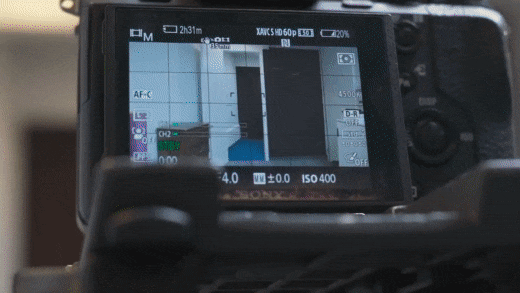
With the tripod set up, film yourself walking behind the door toward the camera. Get close to the camera, then walk back to the door. Then, cross the doorway slowly before walking out of the frame. Now let’s get editing with Wondershare Filmora.

Step 1 Fire up Wondershare Filmora, then import the clip on the video editor. After that, move the clip to the timeline by merely dragging it. Add two clips on the first and second tracks.
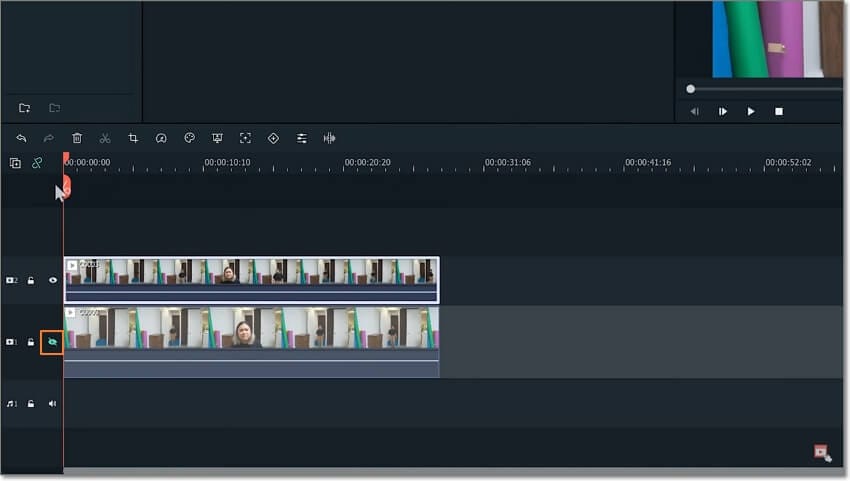
Step 2 Now proceed to hide the first track before adding a freeze frame on the second track. To do that, move the playhead to find the starting scene with the door frame without your subject. Then, right-click the clip and tap Add Freeze Frame. After that, extend the freeze frame area and cut out the rest of the clip.
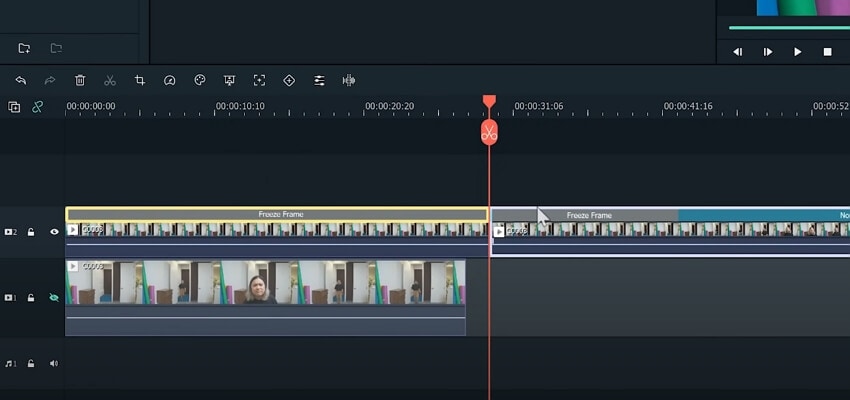
Step 3 Next, click the Effect button and find the Image Mask effect in the Utility folder. Now drag the effect to the top layer.
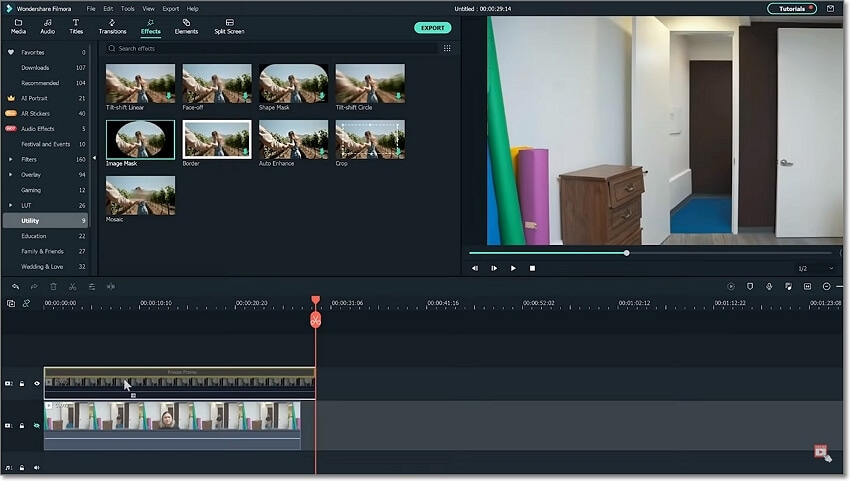
Step 4 Double-click the clip to open the video editing options, then choose a rectangle image mast under Video Effects. Ensure the mask is inverted by clicking the Invert Mask checkbox. Now adjust the mast to match the door frame before clicking Ok.
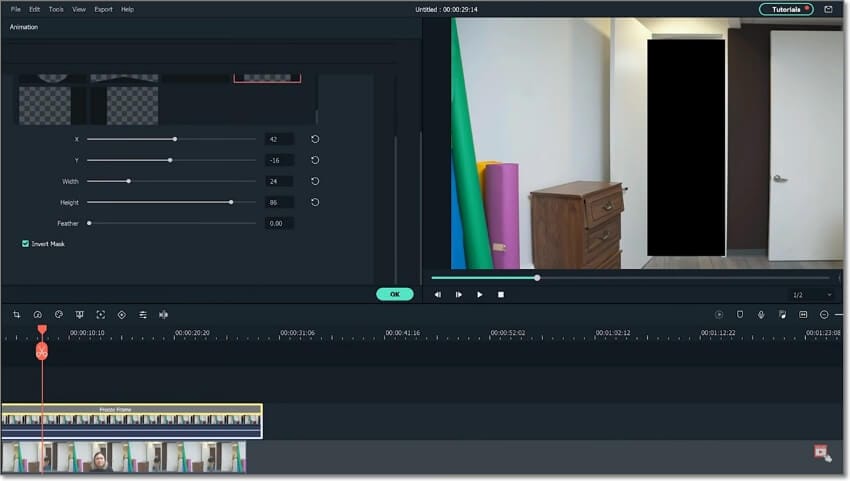
Step 5 Up to this point, unhide the first track, then find the scene where the subject appears on the door frame. On the first track, cut the clip before the subject appears on the stage before cutting the scene where the subject crosses the door frame for the second time on the second track. Now play the video to view your masking effect.

Masking Trick: 2
In the second masking effect, we want to create a subject walking in and outside a tree. To do that, find a tree with a clear background, then place your camera to film the center of the tree trunk where the subject will be walking.
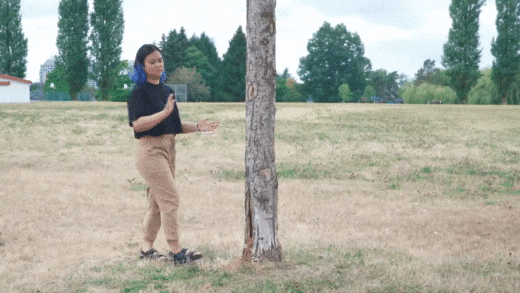
Now film the subject walking from one side of the tree, stop for a second, and then turn back. They should repeat the same action, but this time they’ll walk forward outside the frame after the one-second stop. That’s all!

Step 1 Import the clip on Filmora, then add the footage on the first and second timelines. After that, hide the first track, then find the scene where the subject walks forward away from the tree in the second track. Cut off the area before that action.
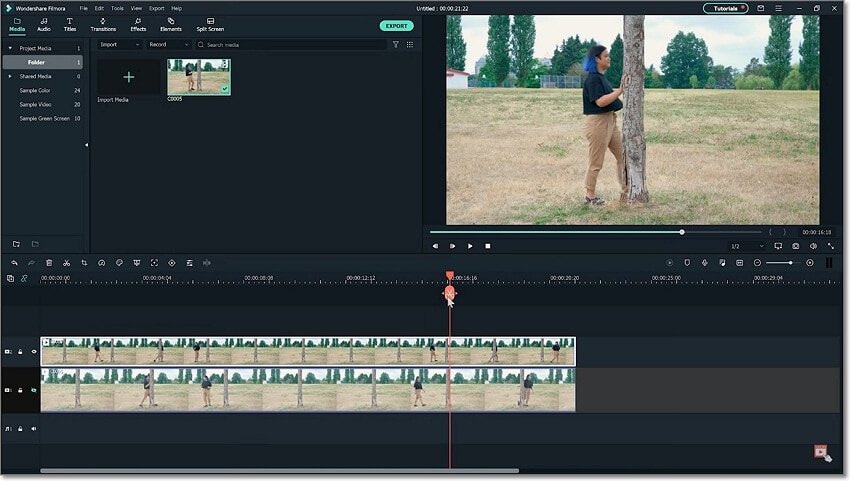
Step 2 Next, click Effects, choose Utility, then drag the Image Mask effect on the second video track. Then, double-click the second clip, select Video Effects, and choose a rectangular option that masks the right side of the frame.
Now adjust the mask until it covers the entire right side of the tree. After that, unhide the first clip and move the second to match the first clip’s timing. You can also cut out everything outside the scene of the first clip.
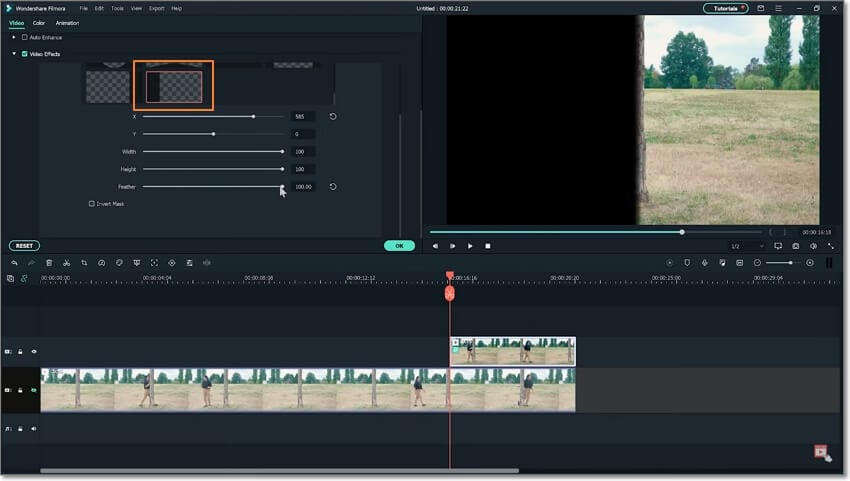
Step 3 Play the video to see your subject walking in both directions of the tree.
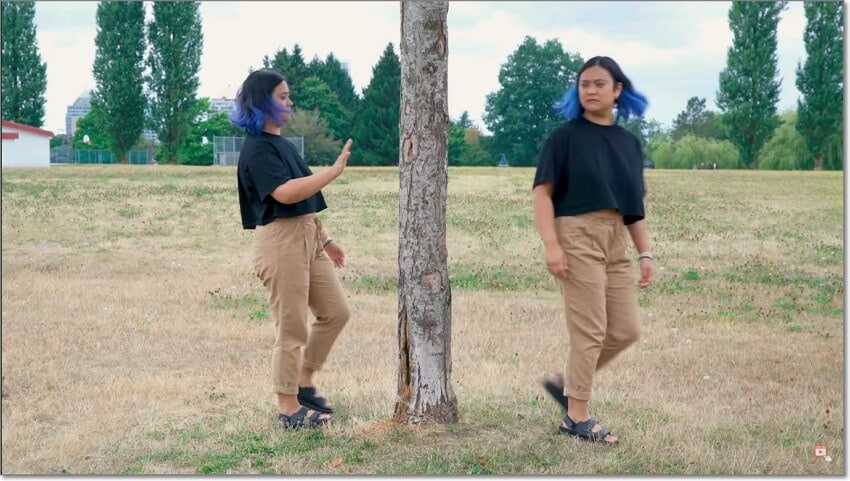
Masking Trick 3:
For this masking illusion, we’ll create a video with a subject jumping over a house. So, set up your camera tripod on a low level in front of the building. You can also add a mark on the ground for your subject to know where to jump.
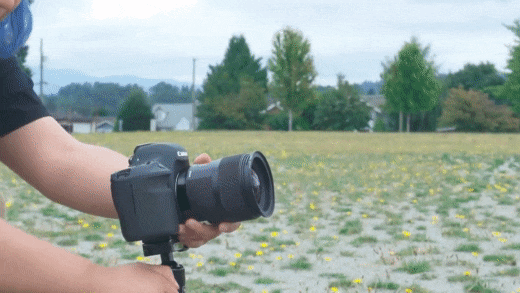
Now tell your subject to walk to the marker before jumping and walking out of the scene.
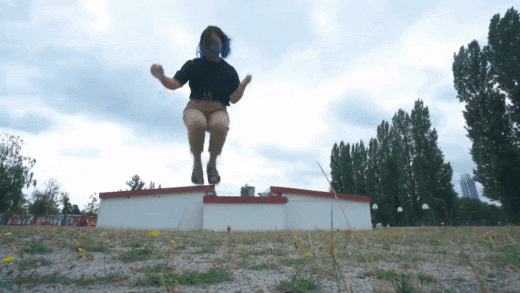
Step 1 Import the clip into Filmora and add it to the first and second tracks. Now hide the first track before finding the scene without the subject in the second track and add a freeze frame. After that, extend the freeze frame area and cut out the rest of the clip.
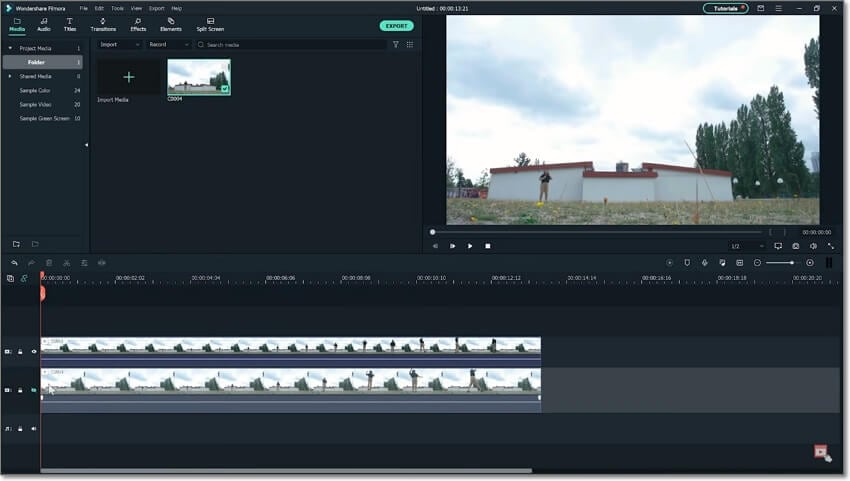
Step 2 Now, it’s time to customize the clip with a mask. To do that, head to the Utility folder under Effects and choose Image Mask. Click the Invert Mask box to invert the mask.
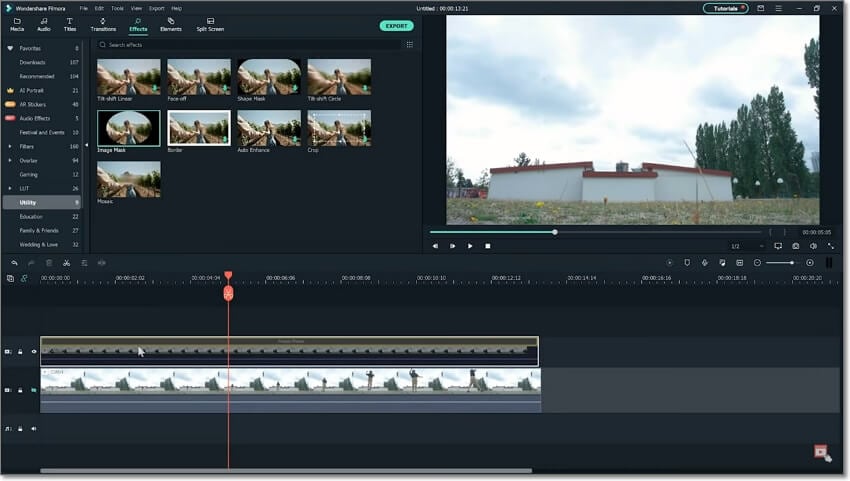
Step 3 Double-click the video track and choose an image mask under Video Effects. Note that you may need several combinations of masks to mask out the sky and leave the building. So, play around with different masking shapes until the sky is covered.
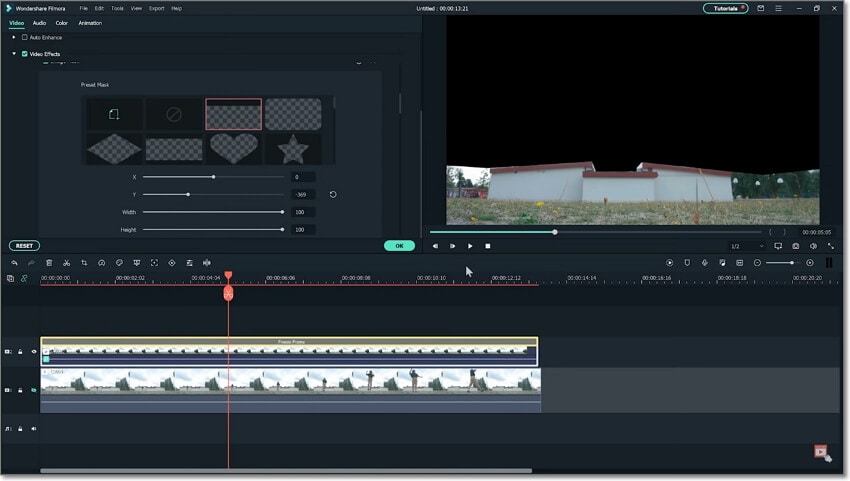
Step 4 After masking, unhide the first track on the timeline before playing the video to find the scene where the subject appears and cut off everything before that scene. Also, find the scene where the subject jumps in the air and cut the clip in the second track. Then, delete everything after that scene.
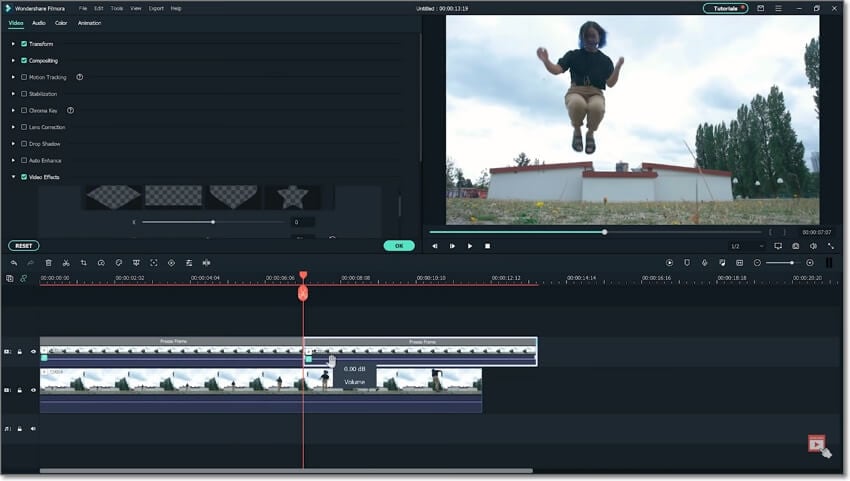
Step 5 Play the video to see your subject jumping over the building and walking away from the scene.
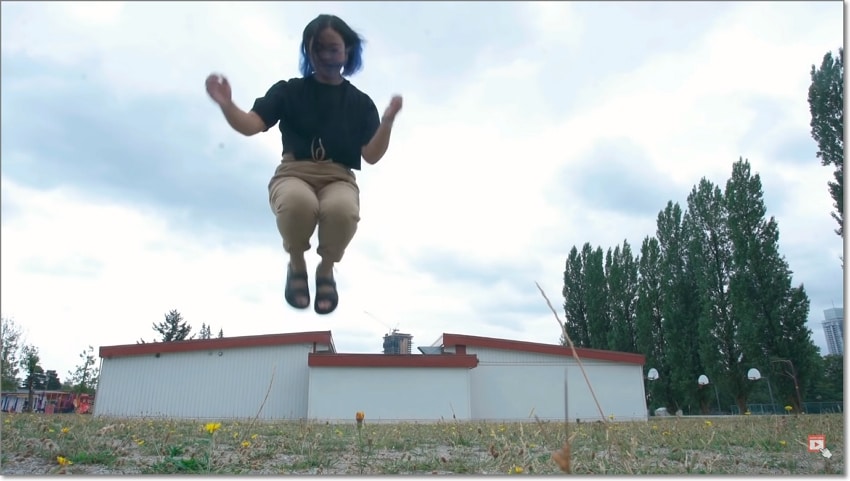
Conclusion
That was easy, right? Playing around with Filmora’s masking tools can create incredible masking illusions like the ones we’ve discussed. And don’t forget this video editor has many more creative possibilities. You should try these masking tricks!
Free Download For macOS 10.14 or later
Masking Trick 1:
First, you need to shoot footage to add the masking effect. To do that, find a doorway with enough space to walk back and forth before setting up a camera with a tripod facing the entrance. Make sure you set the camera at the center height of the door to prevent lens distortion.

With the tripod set up, film yourself walking behind the door toward the camera. Get close to the camera, then walk back to the door. Then, cross the doorway slowly before walking out of the frame. Now let’s get editing with Wondershare Filmora.

Step 1 Fire up Wondershare Filmora, then import the clip on the video editor. After that, move the clip to the timeline by merely dragging it. Add two clips on the first and second tracks.

Step 2 Now proceed to hide the first track before adding a freeze frame on the second track. To do that, move the playhead to find the starting scene with the door frame without your subject. Then, right-click the clip and tap Add Freeze Frame. After that, extend the freeze frame area and cut out the rest of the clip.

Step 3 Next, click the Effect button and find the Image Mask effect in the Utility folder. Now drag the effect to the top layer.

Step 4 Double-click the clip to open the video editing options, then choose a rectangle image mast under Video Effects. Ensure the mask is inverted by clicking the Invert Mask checkbox. Now adjust the mast to match the door frame before clicking Ok.

Step 5 Up to this point, unhide the first track, then find the scene where the subject appears on the door frame. On the first track, cut the clip before the subject appears on the stage before cutting the scene where the subject crosses the door frame for the second time on the second track. Now play the video to view your masking effect.

Masking Trick: 2
In the second masking effect, we want to create a subject walking in and outside a tree. To do that, find a tree with a clear background, then place your camera to film the center of the tree trunk where the subject will be walking.

Now film the subject walking from one side of the tree, stop for a second, and then turn back. They should repeat the same action, but this time they’ll walk forward outside the frame after the one-second stop. That’s all!

Step 1 Import the clip on Filmora, then add the footage on the first and second timelines. After that, hide the first track, then find the scene where the subject walks forward away from the tree in the second track. Cut off the area before that action.

Step 2 Next, click Effects, choose Utility, then drag the Image Mask effect on the second video track. Then, double-click the second clip, select Video Effects, and choose a rectangular option that masks the right side of the frame.
Now adjust the mask until it covers the entire right side of the tree. After that, unhide the first clip and move the second to match the first clip’s timing. You can also cut out everything outside the scene of the first clip.

Step 3 Play the video to see your subject walking in both directions of the tree.

Masking Trick 3:
For this masking illusion, we’ll create a video with a subject jumping over a house. So, set up your camera tripod on a low level in front of the building. You can also add a mark on the ground for your subject to know where to jump.

Now tell your subject to walk to the marker before jumping and walking out of the scene.

Step 1 Import the clip into Filmora and add it to the first and second tracks. Now hide the first track before finding the scene without the subject in the second track and add a freeze frame. After that, extend the freeze frame area and cut out the rest of the clip.

Step 2 Now, it’s time to customize the clip with a mask. To do that, head to the Utility folder under Effects and choose Image Mask. Click the Invert Mask box to invert the mask.

Step 3 Double-click the video track and choose an image mask under Video Effects. Note that you may need several combinations of masks to mask out the sky and leave the building. So, play around with different masking shapes until the sky is covered.

Step 4 After masking, unhide the first track on the timeline before playing the video to find the scene where the subject appears and cut off everything before that scene. Also, find the scene where the subject jumps in the air and cut the clip in the second track. Then, delete everything after that scene.

Step 5 Play the video to see your subject jumping over the building and walking away from the scene.

Conclusion
That was easy, right? Playing around with Filmora’s masking tools can create incredible masking illusions like the ones we’ve discussed. And don’t forget this video editor has many more creative possibilities. You should try these masking tricks!
Free Download For macOS 10.14 or later
Masking Trick 1:
First, you need to shoot footage to add the masking effect. To do that, find a doorway with enough space to walk back and forth before setting up a camera with a tripod facing the entrance. Make sure you set the camera at the center height of the door to prevent lens distortion.

With the tripod set up, film yourself walking behind the door toward the camera. Get close to the camera, then walk back to the door. Then, cross the doorway slowly before walking out of the frame. Now let’s get editing with Wondershare Filmora.

Step 1 Fire up Wondershare Filmora, then import the clip on the video editor. After that, move the clip to the timeline by merely dragging it. Add two clips on the first and second tracks.

Step 2 Now proceed to hide the first track before adding a freeze frame on the second track. To do that, move the playhead to find the starting scene with the door frame without your subject. Then, right-click the clip and tap Add Freeze Frame. After that, extend the freeze frame area and cut out the rest of the clip.

Step 3 Next, click the Effect button and find the Image Mask effect in the Utility folder. Now drag the effect to the top layer.

Step 4 Double-click the clip to open the video editing options, then choose a rectangle image mast under Video Effects. Ensure the mask is inverted by clicking the Invert Mask checkbox. Now adjust the mast to match the door frame before clicking Ok.

Step 5 Up to this point, unhide the first track, then find the scene where the subject appears on the door frame. On the first track, cut the clip before the subject appears on the stage before cutting the scene where the subject crosses the door frame for the second time on the second track. Now play the video to view your masking effect.

Masking Trick: 2
In the second masking effect, we want to create a subject walking in and outside a tree. To do that, find a tree with a clear background, then place your camera to film the center of the tree trunk where the subject will be walking.

Now film the subject walking from one side of the tree, stop for a second, and then turn back. They should repeat the same action, but this time they’ll walk forward outside the frame after the one-second stop. That’s all!

Step 1 Import the clip on Filmora, then add the footage on the first and second timelines. After that, hide the first track, then find the scene where the subject walks forward away from the tree in the second track. Cut off the area before that action.

Step 2 Next, click Effects, choose Utility, then drag the Image Mask effect on the second video track. Then, double-click the second clip, select Video Effects, and choose a rectangular option that masks the right side of the frame.
Now adjust the mask until it covers the entire right side of the tree. After that, unhide the first clip and move the second to match the first clip’s timing. You can also cut out everything outside the scene of the first clip.

Step 3 Play the video to see your subject walking in both directions of the tree.

Masking Trick 3:
For this masking illusion, we’ll create a video with a subject jumping over a house. So, set up your camera tripod on a low level in front of the building. You can also add a mark on the ground for your subject to know where to jump.

Now tell your subject to walk to the marker before jumping and walking out of the scene.

Step 1 Import the clip into Filmora and add it to the first and second tracks. Now hide the first track before finding the scene without the subject in the second track and add a freeze frame. After that, extend the freeze frame area and cut out the rest of the clip.

Step 2 Now, it’s time to customize the clip with a mask. To do that, head to the Utility folder under Effects and choose Image Mask. Click the Invert Mask box to invert the mask.

Step 3 Double-click the video track and choose an image mask under Video Effects. Note that you may need several combinations of masks to mask out the sky and leave the building. So, play around with different masking shapes until the sky is covered.

Step 4 After masking, unhide the first track on the timeline before playing the video to find the scene where the subject appears and cut off everything before that scene. Also, find the scene where the subject jumps in the air and cut the clip in the second track. Then, delete everything after that scene.

Step 5 Play the video to see your subject jumping over the building and walking away from the scene.

Conclusion
That was easy, right? Playing around with Filmora’s masking tools can create incredible masking illusions like the ones we’ve discussed. And don’t forget this video editor has many more creative possibilities. You should try these masking tricks!
Free Download For macOS 10.14 or later
Masking Trick 1:
First, you need to shoot footage to add the masking effect. To do that, find a doorway with enough space to walk back and forth before setting up a camera with a tripod facing the entrance. Make sure you set the camera at the center height of the door to prevent lens distortion.

With the tripod set up, film yourself walking behind the door toward the camera. Get close to the camera, then walk back to the door. Then, cross the doorway slowly before walking out of the frame. Now let’s get editing with Wondershare Filmora.

Step 1 Fire up Wondershare Filmora, then import the clip on the video editor. After that, move the clip to the timeline by merely dragging it. Add two clips on the first and second tracks.

Step 2 Now proceed to hide the first track before adding a freeze frame on the second track. To do that, move the playhead to find the starting scene with the door frame without your subject. Then, right-click the clip and tap Add Freeze Frame. After that, extend the freeze frame area and cut out the rest of the clip.

Step 3 Next, click the Effect button and find the Image Mask effect in the Utility folder. Now drag the effect to the top layer.

Step 4 Double-click the clip to open the video editing options, then choose a rectangle image mast under Video Effects. Ensure the mask is inverted by clicking the Invert Mask checkbox. Now adjust the mast to match the door frame before clicking Ok.

Step 5 Up to this point, unhide the first track, then find the scene where the subject appears on the door frame. On the first track, cut the clip before the subject appears on the stage before cutting the scene where the subject crosses the door frame for the second time on the second track. Now play the video to view your masking effect.

Masking Trick: 2
In the second masking effect, we want to create a subject walking in and outside a tree. To do that, find a tree with a clear background, then place your camera to film the center of the tree trunk where the subject will be walking.

Now film the subject walking from one side of the tree, stop for a second, and then turn back. They should repeat the same action, but this time they’ll walk forward outside the frame after the one-second stop. That’s all!

Step 1 Import the clip on Filmora, then add the footage on the first and second timelines. After that, hide the first track, then find the scene where the subject walks forward away from the tree in the second track. Cut off the area before that action.

Step 2 Next, click Effects, choose Utility, then drag the Image Mask effect on the second video track. Then, double-click the second clip, select Video Effects, and choose a rectangular option that masks the right side of the frame.
Now adjust the mask until it covers the entire right side of the tree. After that, unhide the first clip and move the second to match the first clip’s timing. You can also cut out everything outside the scene of the first clip.

Step 3 Play the video to see your subject walking in both directions of the tree.

Masking Trick 3:
For this masking illusion, we’ll create a video with a subject jumping over a house. So, set up your camera tripod on a low level in front of the building. You can also add a mark on the ground for your subject to know where to jump.

Now tell your subject to walk to the marker before jumping and walking out of the scene.

Step 1 Import the clip into Filmora and add it to the first and second tracks. Now hide the first track before finding the scene without the subject in the second track and add a freeze frame. After that, extend the freeze frame area and cut out the rest of the clip.

Step 2 Now, it’s time to customize the clip with a mask. To do that, head to the Utility folder under Effects and choose Image Mask. Click the Invert Mask box to invert the mask.

Step 3 Double-click the video track and choose an image mask under Video Effects. Note that you may need several combinations of masks to mask out the sky and leave the building. So, play around with different masking shapes until the sky is covered.

Step 4 After masking, unhide the first track on the timeline before playing the video to find the scene where the subject appears and cut off everything before that scene. Also, find the scene where the subject jumps in the air and cut the clip in the second track. Then, delete everything after that scene.

Step 5 Play the video to see your subject jumping over the building and walking away from the scene.

Conclusion
That was easy, right? Playing around with Filmora’s masking tools can create incredible masking illusions like the ones we’ve discussed. And don’t forget this video editor has many more creative possibilities. You should try these masking tricks!
Basic Knowledge About WMV Format and Best WMV Video Editor
WMV is the default file format for Windows Media Player. It was developed as an alternative to the RealVideo codec for web streaming purposes. WMV can be streamed on the internet and played by various media players. YouTube allows the users to upload WMV file format content.
Now that you know this about WMV format, there are some more details to share, so let’s start. The article understudy will discuss everything in detail; buckle up!
In this article
02 Advantage and Disadvantage of WMV Video Format
03 Best MMV Video Editor - Wondershare Filmora
04 How to Edit WMV Video File?
05 WMV VS. MP4: What’s the Difference?
Part 1. What Is WMV File?
WMV file format is from a sequence of video codecs, and it was developed by Microsoft. The full abbreviation of WMV is ‘Windows Media Video.’ WMV is a compressed file container that was made for the Windows Media Framework. It is mainly used for the video content that is to be sold either online or through HD DVDs and Blu-ray Discs.
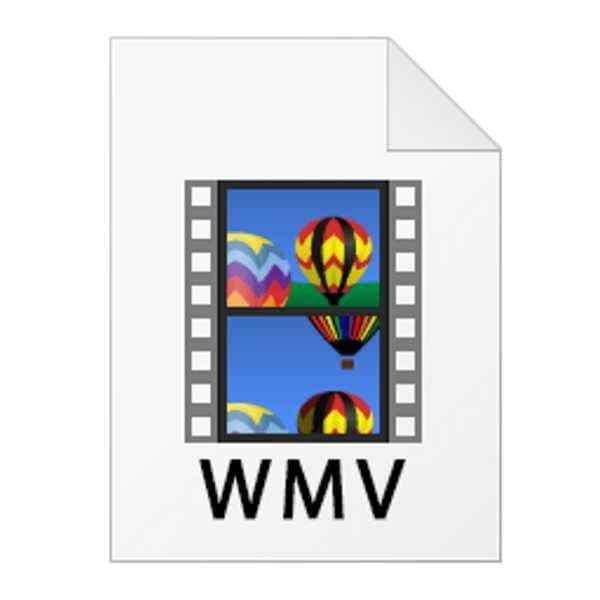
WMV format files support the encryption for the use with Digital Rights Management (DRM) systems, protecting the content from copywriting and any unlawful production. The WMV file may contain animation, high-definition videos, TV episodes, or video clips.
WMV compresses large files for better data transmission over a network while maintaining quality standards. It is specifically designed to run on all Windows devices. After standardization by the Society of Motion Pictures and Television Engineering (SMPTE), WMV is now considered to be an open standard format.
Part 2. Advantage and Disadvantage of WMV Video Format
Like everything, the WMV file format has its benefits and drawbacks, but not everyone knows much about them. The following section of this article will talk about the benefits and drawbacks; let’s get started!
Advantages of WMV Format
- WMV format is excellent for web videos as it acquires little disc memory space and thus takes less time in loading.
- The files are compressed and have reduced size; hence it is easy to transfer WMV file format via emails etc.
- The format is widely used on Windows and is suitable for storing short animations as well as compressed videos.
- Do you know anything about the compression ratio? Well, if we compare WMV to MPEG-4, WMV format has a 2x compression ratio.
- The format also works on the Web through Google Drive. Also, the quality of the video is maintained with Windows video format.
Disadvantages of WMV Format
- Although the small size is better but not, every application works with the tiny file size as offered by WMV format.
- If you are a Mac user and wish to play WMV files on your Mac, you need plugins like Flip4Mac.
Part 3. Best MMV Video Editor -Wondershare Filmora
Wondershare Filmora has always been on the top of the list whenever we talk about video editing. The software is used worldwide by professionals and also newbies. This is because Filmora provides an endless range of features that can create captivating videos. Let’s share a few features:
- Stabilize Video: Your video might be shaky, or maybe single footage can be shaky. Do you know a way to fix this? Try Stabilize Video feature from Filmora. This feature helps you to smooth all the shaky scenes in your video.
- Motion Tracking: In the editing world, Motion Tracking is the most fun type of feature. With this feature, you can move objects like text, audio, video, elements, etc., by tracking the movements in your video.
- Auto Highlight: Do you know a feature that will save your time and effort? It’s Auto Highlight. The feature spontaneously extracts the highlight from the clip and saves your video trimming time.
For Win 7 or later (64-bit)
For macOS 10.12 or later
Part 4. How to Edit WMV Video File?
For editing, Wondershare Filmora is an ideal software to use. Now that you know about Filmora and its stunning features, do you have any knowledge about how to use it? Well, don’t worry. We are here to guide you about how you can edit WMV file format videos in Filmora. Just follow the simple steps shared below:
Step 1: Get the Media File
Start by launching the software on your respective device. Once Filmora opens, you can import the media file by drag and drop. Or else, tap on the ‘File’ tab and move to the ‘Import Media’ option. From the submenu, select the ‘Import Media Files’ option to add the WMV format file.
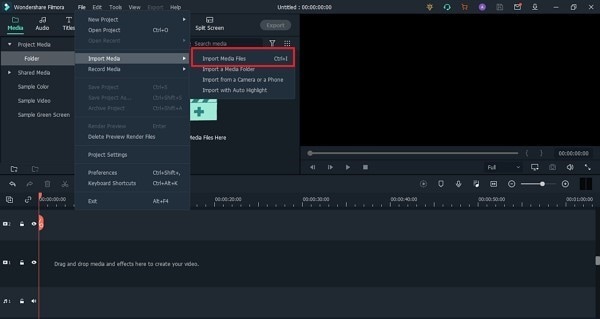
Step 2: Head to Editor Timeline
You should know that editing is only possible when your file is on the timeline. For that, after a successful file import, simply drag and drop the media file to the timeline and let the fun begins.
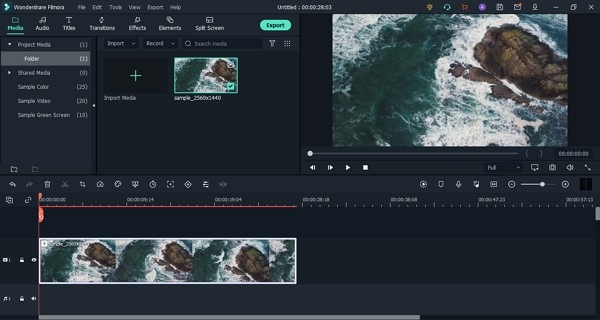
Step 3: Add Video Effects
Once the file is in the timeline, start editing. You can add various video effects to your WMV video file from this section. You can get effects like Canvas, Cool Film, Four Seasons, etc., and can also add overlays, filters, etc.
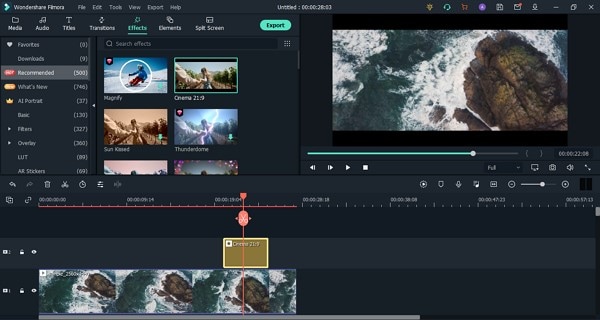
Step 4: Use Title Template
Filmora offers you so many different and cool title templates. You only have to select the best template from the options. You can go for School Pack, Channel Subscribe, Romantic Pack, etc. Moreover, add Lower Thirds, Subtitles, Openers, and a lot more.
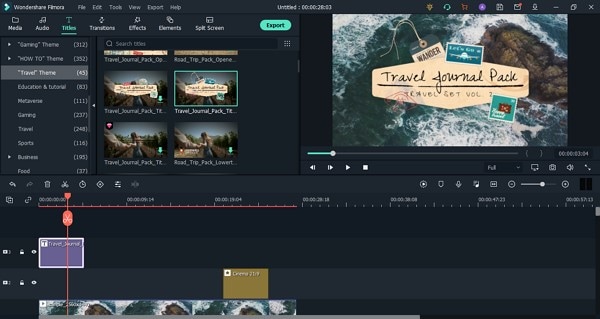
Step 5: Export the WMV File
After all the editing is complete, get the WMV format file exported to your device. For that, hit the ‘Export’ button and from the ‘Locals’ section, select your preferred output file format.
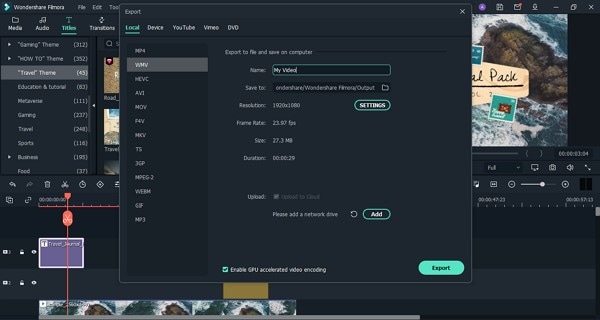
Part 5. WMV VS. MP4: What’s the Difference?
MP4 is far more popular than the WMV file format. The world is shifting on the internet; MP4 is widely used and loved online. On the other hand, WMV is popular with Windows users, along with DVD and Blu-ray collectors.
If we talk about the supported software for MP4 and WMV, MP4 has bigger support. WMV is supported by fewer video players and online video editing tools. On the contrary, MP4 is supported by all the video players available for both Windows and Mac users; along with that, every online tool also supports MP4 format for video editing.
Now the world demands quality. In terms of quality, MP4 has better quality than WMV. WMV has lost the battle of quality provision against WMV. MP4 is a larger file than WMV in terms of file size. It is less compressed than WMV format, but the compression gives WMV an advantage over MP4.
Having a compressed file format produces files of smaller size, which can be easily stored. Easy storage of video files makes WMV a better option in places where the quality of the video can be compromised.
Bottom Line
After reading this article, we hope that you have increased your knowledge regarding the WMV file format. We talked about the pros and cons of the WMV format. Moreover, we also shared ways to edit a WMV video with the best video editor, Wondershare Filmora.
Let’s tell you more about the video editing software. Wondershare Filmora is not just a Video Editor; it’s also an Audio Editor with various diverse features like Audio Denoise, Silence Detection, etc. The software is easy to use with a drag and drop facility. You can create and edit stunning videos with the multi-track editor.
For Win 7 or later (64-bit)
For macOS 10.12 or later
02 Advantage and Disadvantage of WMV Video Format
03 Best MMV Video Editor - Wondershare Filmora
04 How to Edit WMV Video File?
05 WMV VS. MP4: What’s the Difference?
Part 1. What Is WMV File?
WMV file format is from a sequence of video codecs, and it was developed by Microsoft. The full abbreviation of WMV is ‘Windows Media Video.’ WMV is a compressed file container that was made for the Windows Media Framework. It is mainly used for the video content that is to be sold either online or through HD DVDs and Blu-ray Discs.

WMV format files support the encryption for the use with Digital Rights Management (DRM) systems, protecting the content from copywriting and any unlawful production. The WMV file may contain animation, high-definition videos, TV episodes, or video clips.
WMV compresses large files for better data transmission over a network while maintaining quality standards. It is specifically designed to run on all Windows devices. After standardization by the Society of Motion Pictures and Television Engineering (SMPTE), WMV is now considered to be an open standard format.
Part 2. Advantage and Disadvantage of WMV Video Format
Like everything, the WMV file format has its benefits and drawbacks, but not everyone knows much about them. The following section of this article will talk about the benefits and drawbacks; let’s get started!
Advantages of WMV Format
- WMV format is excellent for web videos as it acquires little disc memory space and thus takes less time in loading.
- The files are compressed and have reduced size; hence it is easy to transfer WMV file format via emails etc.
- The format is widely used on Windows and is suitable for storing short animations as well as compressed videos.
- Do you know anything about the compression ratio? Well, if we compare WMV to MPEG-4, WMV format has a 2x compression ratio.
- The format also works on the Web through Google Drive. Also, the quality of the video is maintained with Windows video format.
Disadvantages of WMV Format
- Although the small size is better but not, every application works with the tiny file size as offered by WMV format.
- If you are a Mac user and wish to play WMV files on your Mac, you need plugins like Flip4Mac.
Part 3. Best MMV Video Editor -Wondershare Filmora
Wondershare Filmora has always been on the top of the list whenever we talk about video editing. The software is used worldwide by professionals and also newbies. This is because Filmora provides an endless range of features that can create captivating videos. Let’s share a few features:
- Stabilize Video: Your video might be shaky, or maybe single footage can be shaky. Do you know a way to fix this? Try Stabilize Video feature from Filmora. This feature helps you to smooth all the shaky scenes in your video.
- Motion Tracking: In the editing world, Motion Tracking is the most fun type of feature. With this feature, you can move objects like text, audio, video, elements, etc., by tracking the movements in your video.
- Auto Highlight: Do you know a feature that will save your time and effort? It’s Auto Highlight. The feature spontaneously extracts the highlight from the clip and saves your video trimming time.
For Win 7 or later (64-bit)
For macOS 10.12 or later
Part 4. How to Edit WMV Video File?
For editing, Wondershare Filmora is an ideal software to use. Now that you know about Filmora and its stunning features, do you have any knowledge about how to use it? Well, don’t worry. We are here to guide you about how you can edit WMV file format videos in Filmora. Just follow the simple steps shared below:
Step 1: Get the Media File
Start by launching the software on your respective device. Once Filmora opens, you can import the media file by drag and drop. Or else, tap on the ‘File’ tab and move to the ‘Import Media’ option. From the submenu, select the ‘Import Media Files’ option to add the WMV format file.

Step 2: Head to Editor Timeline
You should know that editing is only possible when your file is on the timeline. For that, after a successful file import, simply drag and drop the media file to the timeline and let the fun begins.

Step 3: Add Video Effects
Once the file is in the timeline, start editing. You can add various video effects to your WMV video file from this section. You can get effects like Canvas, Cool Film, Four Seasons, etc., and can also add overlays, filters, etc.

Step 4: Use Title Template
Filmora offers you so many different and cool title templates. You only have to select the best template from the options. You can go for School Pack, Channel Subscribe, Romantic Pack, etc. Moreover, add Lower Thirds, Subtitles, Openers, and a lot more.

Step 5: Export the WMV File
After all the editing is complete, get the WMV format file exported to your device. For that, hit the ‘Export’ button and from the ‘Locals’ section, select your preferred output file format.

Part 5. WMV VS. MP4: What’s the Difference?
MP4 is far more popular than the WMV file format. The world is shifting on the internet; MP4 is widely used and loved online. On the other hand, WMV is popular with Windows users, along with DVD and Blu-ray collectors.
If we talk about the supported software for MP4 and WMV, MP4 has bigger support. WMV is supported by fewer video players and online video editing tools. On the contrary, MP4 is supported by all the video players available for both Windows and Mac users; along with that, every online tool also supports MP4 format for video editing.
Now the world demands quality. In terms of quality, MP4 has better quality than WMV. WMV has lost the battle of quality provision against WMV. MP4 is a larger file than WMV in terms of file size. It is less compressed than WMV format, but the compression gives WMV an advantage over MP4.
Having a compressed file format produces files of smaller size, which can be easily stored. Easy storage of video files makes WMV a better option in places where the quality of the video can be compromised.
Bottom Line
After reading this article, we hope that you have increased your knowledge regarding the WMV file format. We talked about the pros and cons of the WMV format. Moreover, we also shared ways to edit a WMV video with the best video editor, Wondershare Filmora.
Let’s tell you more about the video editing software. Wondershare Filmora is not just a Video Editor; it’s also an Audio Editor with various diverse features like Audio Denoise, Silence Detection, etc. The software is easy to use with a drag and drop facility. You can create and edit stunning videos with the multi-track editor.
For Win 7 or later (64-bit)
For macOS 10.12 or later
02 Advantage and Disadvantage of WMV Video Format
03 Best MMV Video Editor - Wondershare Filmora
04 How to Edit WMV Video File?
05 WMV VS. MP4: What’s the Difference?
Part 1. What Is WMV File?
WMV file format is from a sequence of video codecs, and it was developed by Microsoft. The full abbreviation of WMV is ‘Windows Media Video.’ WMV is a compressed file container that was made for the Windows Media Framework. It is mainly used for the video content that is to be sold either online or through HD DVDs and Blu-ray Discs.

WMV format files support the encryption for the use with Digital Rights Management (DRM) systems, protecting the content from copywriting and any unlawful production. The WMV file may contain animation, high-definition videos, TV episodes, or video clips.
WMV compresses large files for better data transmission over a network while maintaining quality standards. It is specifically designed to run on all Windows devices. After standardization by the Society of Motion Pictures and Television Engineering (SMPTE), WMV is now considered to be an open standard format.
Part 2. Advantage and Disadvantage of WMV Video Format
Like everything, the WMV file format has its benefits and drawbacks, but not everyone knows much about them. The following section of this article will talk about the benefits and drawbacks; let’s get started!
Advantages of WMV Format
- WMV format is excellent for web videos as it acquires little disc memory space and thus takes less time in loading.
- The files are compressed and have reduced size; hence it is easy to transfer WMV file format via emails etc.
- The format is widely used on Windows and is suitable for storing short animations as well as compressed videos.
- Do you know anything about the compression ratio? Well, if we compare WMV to MPEG-4, WMV format has a 2x compression ratio.
- The format also works on the Web through Google Drive. Also, the quality of the video is maintained with Windows video format.
Disadvantages of WMV Format
- Although the small size is better but not, every application works with the tiny file size as offered by WMV format.
- If you are a Mac user and wish to play WMV files on your Mac, you need plugins like Flip4Mac.
Part 3. Best MMV Video Editor -Wondershare Filmora
Wondershare Filmora has always been on the top of the list whenever we talk about video editing. The software is used worldwide by professionals and also newbies. This is because Filmora provides an endless range of features that can create captivating videos. Let’s share a few features:
- Stabilize Video: Your video might be shaky, or maybe single footage can be shaky. Do you know a way to fix this? Try Stabilize Video feature from Filmora. This feature helps you to smooth all the shaky scenes in your video.
- Motion Tracking: In the editing world, Motion Tracking is the most fun type of feature. With this feature, you can move objects like text, audio, video, elements, etc., by tracking the movements in your video.
- Auto Highlight: Do you know a feature that will save your time and effort? It’s Auto Highlight. The feature spontaneously extracts the highlight from the clip and saves your video trimming time.
For Win 7 or later (64-bit)
For macOS 10.12 or later
Part 4. How to Edit WMV Video File?
For editing, Wondershare Filmora is an ideal software to use. Now that you know about Filmora and its stunning features, do you have any knowledge about how to use it? Well, don’t worry. We are here to guide you about how you can edit WMV file format videos in Filmora. Just follow the simple steps shared below:
Step 1: Get the Media File
Start by launching the software on your respective device. Once Filmora opens, you can import the media file by drag and drop. Or else, tap on the ‘File’ tab and move to the ‘Import Media’ option. From the submenu, select the ‘Import Media Files’ option to add the WMV format file.

Step 2: Head to Editor Timeline
You should know that editing is only possible when your file is on the timeline. For that, after a successful file import, simply drag and drop the media file to the timeline and let the fun begins.

Step 3: Add Video Effects
Once the file is in the timeline, start editing. You can add various video effects to your WMV video file from this section. You can get effects like Canvas, Cool Film, Four Seasons, etc., and can also add overlays, filters, etc.

Step 4: Use Title Template
Filmora offers you so many different and cool title templates. You only have to select the best template from the options. You can go for School Pack, Channel Subscribe, Romantic Pack, etc. Moreover, add Lower Thirds, Subtitles, Openers, and a lot more.

Step 5: Export the WMV File
After all the editing is complete, get the WMV format file exported to your device. For that, hit the ‘Export’ button and from the ‘Locals’ section, select your preferred output file format.

Part 5. WMV VS. MP4: What’s the Difference?
MP4 is far more popular than the WMV file format. The world is shifting on the internet; MP4 is widely used and loved online. On the other hand, WMV is popular with Windows users, along with DVD and Blu-ray collectors.
If we talk about the supported software for MP4 and WMV, MP4 has bigger support. WMV is supported by fewer video players and online video editing tools. On the contrary, MP4 is supported by all the video players available for both Windows and Mac users; along with that, every online tool also supports MP4 format for video editing.
Now the world demands quality. In terms of quality, MP4 has better quality than WMV. WMV has lost the battle of quality provision against WMV. MP4 is a larger file than WMV in terms of file size. It is less compressed than WMV format, but the compression gives WMV an advantage over MP4.
Having a compressed file format produces files of smaller size, which can be easily stored. Easy storage of video files makes WMV a better option in places where the quality of the video can be compromised.
Bottom Line
After reading this article, we hope that you have increased your knowledge regarding the WMV file format. We talked about the pros and cons of the WMV format. Moreover, we also shared ways to edit a WMV video with the best video editor, Wondershare Filmora.
Let’s tell you more about the video editing software. Wondershare Filmora is not just a Video Editor; it’s also an Audio Editor with various diverse features like Audio Denoise, Silence Detection, etc. The software is easy to use with a drag and drop facility. You can create and edit stunning videos with the multi-track editor.
For Win 7 or later (64-bit)
For macOS 10.12 or later
02 Advantage and Disadvantage of WMV Video Format
03 Best MMV Video Editor - Wondershare Filmora
04 How to Edit WMV Video File?
05 WMV VS. MP4: What’s the Difference?
Part 1. What Is WMV File?
WMV file format is from a sequence of video codecs, and it was developed by Microsoft. The full abbreviation of WMV is ‘Windows Media Video.’ WMV is a compressed file container that was made for the Windows Media Framework. It is mainly used for the video content that is to be sold either online or through HD DVDs and Blu-ray Discs.

WMV format files support the encryption for the use with Digital Rights Management (DRM) systems, protecting the content from copywriting and any unlawful production. The WMV file may contain animation, high-definition videos, TV episodes, or video clips.
WMV compresses large files for better data transmission over a network while maintaining quality standards. It is specifically designed to run on all Windows devices. After standardization by the Society of Motion Pictures and Television Engineering (SMPTE), WMV is now considered to be an open standard format.
Part 2. Advantage and Disadvantage of WMV Video Format
Like everything, the WMV file format has its benefits and drawbacks, but not everyone knows much about them. The following section of this article will talk about the benefits and drawbacks; let’s get started!
Advantages of WMV Format
- WMV format is excellent for web videos as it acquires little disc memory space and thus takes less time in loading.
- The files are compressed and have reduced size; hence it is easy to transfer WMV file format via emails etc.
- The format is widely used on Windows and is suitable for storing short animations as well as compressed videos.
- Do you know anything about the compression ratio? Well, if we compare WMV to MPEG-4, WMV format has a 2x compression ratio.
- The format also works on the Web through Google Drive. Also, the quality of the video is maintained with Windows video format.
Disadvantages of WMV Format
- Although the small size is better but not, every application works with the tiny file size as offered by WMV format.
- If you are a Mac user and wish to play WMV files on your Mac, you need plugins like Flip4Mac.
Part 3. Best MMV Video Editor -Wondershare Filmora
Wondershare Filmora has always been on the top of the list whenever we talk about video editing. The software is used worldwide by professionals and also newbies. This is because Filmora provides an endless range of features that can create captivating videos. Let’s share a few features:
- Stabilize Video: Your video might be shaky, or maybe single footage can be shaky. Do you know a way to fix this? Try Stabilize Video feature from Filmora. This feature helps you to smooth all the shaky scenes in your video.
- Motion Tracking: In the editing world, Motion Tracking is the most fun type of feature. With this feature, you can move objects like text, audio, video, elements, etc., by tracking the movements in your video.
- Auto Highlight: Do you know a feature that will save your time and effort? It’s Auto Highlight. The feature spontaneously extracts the highlight from the clip and saves your video trimming time.
For Win 7 or later (64-bit)
For macOS 10.12 or later
Part 4. How to Edit WMV Video File?
For editing, Wondershare Filmora is an ideal software to use. Now that you know about Filmora and its stunning features, do you have any knowledge about how to use it? Well, don’t worry. We are here to guide you about how you can edit WMV file format videos in Filmora. Just follow the simple steps shared below:
Step 1: Get the Media File
Start by launching the software on your respective device. Once Filmora opens, you can import the media file by drag and drop. Or else, tap on the ‘File’ tab and move to the ‘Import Media’ option. From the submenu, select the ‘Import Media Files’ option to add the WMV format file.

Step 2: Head to Editor Timeline
You should know that editing is only possible when your file is on the timeline. For that, after a successful file import, simply drag and drop the media file to the timeline and let the fun begins.

Step 3: Add Video Effects
Once the file is in the timeline, start editing. You can add various video effects to your WMV video file from this section. You can get effects like Canvas, Cool Film, Four Seasons, etc., and can also add overlays, filters, etc.

Step 4: Use Title Template
Filmora offers you so many different and cool title templates. You only have to select the best template from the options. You can go for School Pack, Channel Subscribe, Romantic Pack, etc. Moreover, add Lower Thirds, Subtitles, Openers, and a lot more.

Step 5: Export the WMV File
After all the editing is complete, get the WMV format file exported to your device. For that, hit the ‘Export’ button and from the ‘Locals’ section, select your preferred output file format.

Part 5. WMV VS. MP4: What’s the Difference?
MP4 is far more popular than the WMV file format. The world is shifting on the internet; MP4 is widely used and loved online. On the other hand, WMV is popular with Windows users, along with DVD and Blu-ray collectors.
If we talk about the supported software for MP4 and WMV, MP4 has bigger support. WMV is supported by fewer video players and online video editing tools. On the contrary, MP4 is supported by all the video players available for both Windows and Mac users; along with that, every online tool also supports MP4 format for video editing.
Now the world demands quality. In terms of quality, MP4 has better quality than WMV. WMV has lost the battle of quality provision against WMV. MP4 is a larger file than WMV in terms of file size. It is less compressed than WMV format, but the compression gives WMV an advantage over MP4.
Having a compressed file format produces files of smaller size, which can be easily stored. Easy storage of video files makes WMV a better option in places where the quality of the video can be compromised.
Bottom Line
After reading this article, we hope that you have increased your knowledge regarding the WMV file format. We talked about the pros and cons of the WMV format. Moreover, we also shared ways to edit a WMV video with the best video editor, Wondershare Filmora.
Let’s tell you more about the video editing software. Wondershare Filmora is not just a Video Editor; it’s also an Audio Editor with various diverse features like Audio Denoise, Silence Detection, etc. The software is easy to use with a drag and drop facility. You can create and edit stunning videos with the multi-track editor.
For Win 7 or later (64-bit)
For macOS 10.12 or later
How To Make Boring Videos Look Cool By B Rolls
Everyone is bored after watching a simple recorded video in which a character explains or tells a story. No one will watch it for more than 4 minutes!
After looking through this article, you will make your video more fascinating and get more views instantly. It’s all just due to B-roll, which will act as a ninja feature in your video. In this regard, Wondershare Filmora will handle everything.
Scroll more to discover two different types of B-roll videos and get an idea of how to make fascinating B-roll videos.
Part 1. What Is a B-roll?
B-roll is alternative or supplementary video footage that editors can use to intercut in between their main video. In that way, B-roll can add more information to a scene.
An additional footage
It is added as a supplementary video to interact with viewers more closely. This feature helps to give more details of a scene.
Visual representation
When the main explanatory video is too boring, you can add a b-roll to represent the movie’s story visually. It can also add to spice up and beat the energy of the narrative.
Without sound
The B-roll shots are mostly without audio or with little background sound. In most cases, the sound of the primary video is continued while the B-roll footage is just shown.
Act as a filler
The criteria for the B-roll is to provide the situation of the storyline. Additionally, it could be utilized as filler in between scenes in a movie or television program. B-roll may be found almost anywhere!
In this article, you will learn about two main kinds of B-rolls and the steps to edit them on Wondershare Filmora . Stick with us to the end!
Free Download For Win 7 or later(64-bit)
Free Download For macOS 10.14 or later
Part 2. Two Types of B-rolls: Explanation Video B-rolls
When recording any explanatory video, the audience may leave it in the middle of a video if a character explains without any visual representation. When explaining something new, showing the object in B-roll can be more effective than just verbally explaining what the audience is seeing.
Let’s take the video we made about microphones as an example. Instead of just verbally introduce the various mics, we inserted B-roll footage to display what they look like and how they can be used. The combination of the visual footage and the background voiceover presents the mic in a more vivid way. Also, it keeps the audience’s attention.

Goal of the explanation B-roll video
The main goal of this type of B-roll is to show your audience what you are talking about instead of just telling them in a dull way.
Part 3. How to Edit Explanation B-roll Footage on Filmora?
After getting the footage and recording shots for B-roll videos, you need to edit it on the Wondershare Filmora. For this, follow the below-mentioned steps:
Step1Download the Wondershare Filmora
There is no need to do any complex process for editing on any platform. Because we have one platform on which every tool is available.
- First of all, you have to download the Wondershare Filmora .
- Then get access to the entire features.
The premium version has new features and effects plugins that make editing more filmy and fun!
Step2Stock media in Filmora
After downloading, it’s time to edit the B-roll video. If you can’t film your own B-roll, you can use stock footage but make sure you have the license to use them.
Filmora has a unique “stock media” option that enables us to use all these elements and more to boost our videos! To add stock media, follow the below steps:
- Open the app or window of Filmora, which you have installed.
- Head towards the tab on the top right side.
- Then click on the Stock Media option and open it.
- A long list of stock videos and images will pop up.
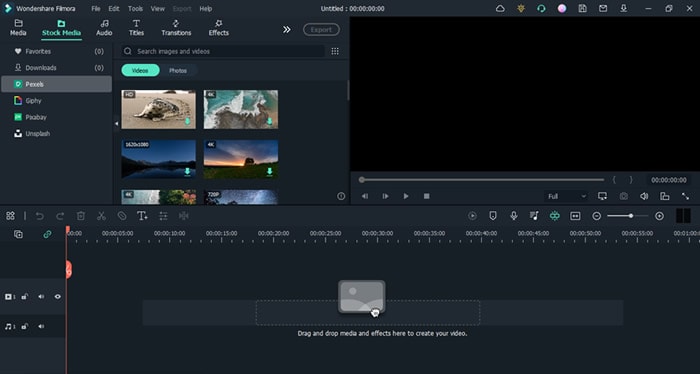
- Select whatever you want, and download it.
- Then drag and drop it in the timeline and insert it between your video.
![]()
Note: Only premium customers will get access to the stock media of the Wondershare Filmora.
Step3Add B-roll in between the main video
The most difficult and frequent asking situation is how you know when to cut to B-roll. To get to know when to insert B-roll, follow the following steps:
- Watch your edits back and check out where you need.
- Sense about the dull and complex points and cut the main video from there.
- The points can be easily fixed with visual aids.
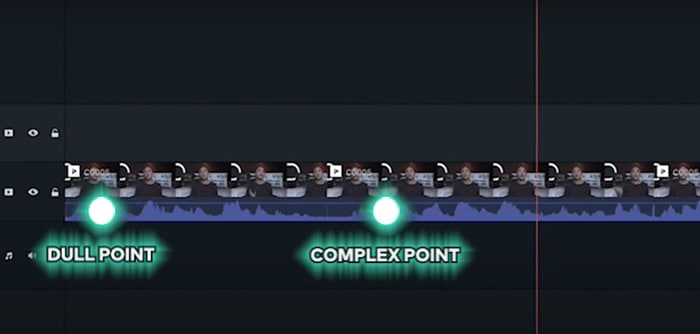
Part 4. Two Types of B-rolls: Storytelling Video B-rolls
During the creation of short films or any storytelling videos, if a person sits and speaks without showing any character or anything else, it will turn boring. Due to this, you have more chances to lose your audience and viewers.
In visual storytelling, if you will insert more clips with close shots, it will make the environment cool. The crazy thing is that you can make mimic shots easily at home by utilizing household objects. Let’s check out one of the examples.
Example 1. Film B-roll footage with food
So let’s add some b-roll to give it more context even if you have a master shot of yourself looking off frame alone.
Step1Write a script
Before making any video, the first step is to write a script for the whole video. If you will have more than two characters, then make dialogues for everyone and practice it again and again to give a fascinating look.
Then speak to your audience, make sure that what you are speaking is vivid and make everything simple and crystal clear.
Step2Shot a primary video
First of all, make a primary video according to your script by implementing a camera at one side, or you can also change the angle of the camera lens during shooting to have a look from all sides.

As you can see that it’s kind of boring for the audience, but we will make it more unique by implementing closer shots. For this, follow the last step:
Step3Make B-roll shots
Make closer shots of things which the character have to select and pick up. Check out two B-roll shots for the main video:
- First, make a closer shot of the object (Snacks) that the character is noticing prior.
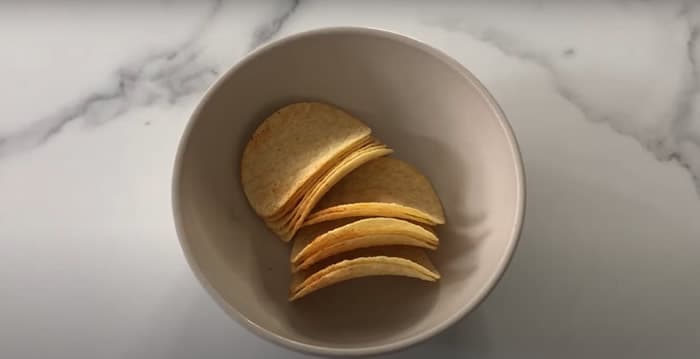
- Second, create more intimate footage of the second object (Banana) which the character will select and grab.
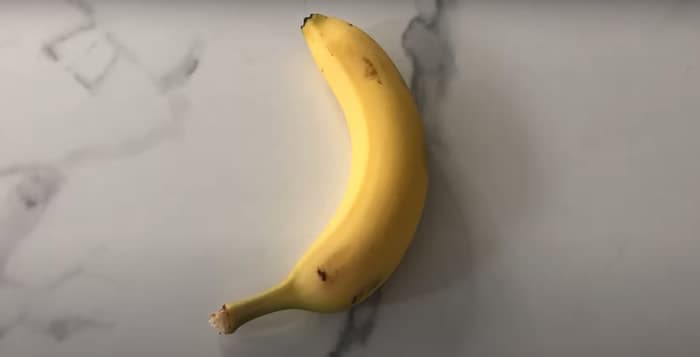
Step4Edit both B-roll footages in Main Video
Now, in the last, insert the B-roll footage in between the primary video from the Filmora and get your results. Enjoy it with your viewers!

Now experiment at home with more daily life activities and create all on Filmora. Check out one more example to create B-roll footage!
Example 2. Make B-roll shots with a cardboard
Try using readily accessible cardboard to create light effects in different shapes and give the film a fantastical place. These methods frequently produce artistic videos that transmit unique moods to viewers.
Only experienced photographers and videographers understand how to use these fundamental tricks to gain viewers into the photos.
The intriguing thing is that if the light is more shaped, it will more accurately reflect the image’s background, setting, and context. Try it out!
Step1Cut the cardboard
You may shape the cardboard any way you desire. We’ll experiment with this by cutting cardboard into the shape of window shades.

Step2Make B-roll footage
Create B-roll footage by moving the cardboard around the light source after giving it shape. The person appears to be seated close to the window and conveys aesthetic vibrancy.

Now, use this B-roll footage in your video and give it a more professional look. The more creative you are, the more audience will attract to you.
Conclusion
Making B-roll shots is creative and fun! You can make all the footage at home by following easy steps. Try out different ones to make your video viral and boost the target audience!
You can easily use Wondershare Filmora during editing and their stock media to save your time in video making. Share your hacks with your audience to get more experience!
Free Download For macOS 10.14 or later
Part 2. Two Types of B-rolls: Explanation Video B-rolls
When recording any explanatory video, the audience may leave it in the middle of a video if a character explains without any visual representation. When explaining something new, showing the object in B-roll can be more effective than just verbally explaining what the audience is seeing.
Let’s take the video we made about microphones as an example. Instead of just verbally introduce the various mics, we inserted B-roll footage to display what they look like and how they can be used. The combination of the visual footage and the background voiceover presents the mic in a more vivid way. Also, it keeps the audience’s attention.

Goal of the explanation B-roll video
The main goal of this type of B-roll is to show your audience what you are talking about instead of just telling them in a dull way.
Part 3. How to Edit Explanation B-roll Footage on Filmora?
After getting the footage and recording shots for B-roll videos, you need to edit it on the Wondershare Filmora. For this, follow the below-mentioned steps:
Step1Download the Wondershare Filmora
There is no need to do any complex process for editing on any platform. Because we have one platform on which every tool is available.
- First of all, you have to download the Wondershare Filmora .
- Then get access to the entire features.
The premium version has new features and effects plugins that make editing more filmy and fun!
Step2Stock media in Filmora
After downloading, it’s time to edit the B-roll video. If you can’t film your own B-roll, you can use stock footage but make sure you have the license to use them.
Filmora has a unique “stock media” option that enables us to use all these elements and more to boost our videos! To add stock media, follow the below steps:
- Open the app or window of Filmora, which you have installed.
- Head towards the tab on the top right side.
- Then click on the Stock Media option and open it.
- A long list of stock videos and images will pop up.

- Select whatever you want, and download it.
- Then drag and drop it in the timeline and insert it between your video.
![]()
Note: Only premium customers will get access to the stock media of the Wondershare Filmora.
Step3Add B-roll in between the main video
The most difficult and frequent asking situation is how you know when to cut to B-roll. To get to know when to insert B-roll, follow the following steps:
- Watch your edits back and check out where you need.
- Sense about the dull and complex points and cut the main video from there.
- The points can be easily fixed with visual aids.

Part 4. Two Types of B-rolls: Storytelling Video B-rolls
During the creation of short films or any storytelling videos, if a person sits and speaks without showing any character or anything else, it will turn boring. Due to this, you have more chances to lose your audience and viewers.
In visual storytelling, if you will insert more clips with close shots, it will make the environment cool. The crazy thing is that you can make mimic shots easily at home by utilizing household objects. Let’s check out one of the examples.
Example 1. Film B-roll footage with food
So let’s add some b-roll to give it more context even if you have a master shot of yourself looking off frame alone.
Step1Write a script
Before making any video, the first step is to write a script for the whole video. If you will have more than two characters, then make dialogues for everyone and practice it again and again to give a fascinating look.
Then speak to your audience, make sure that what you are speaking is vivid and make everything simple and crystal clear.
Step2Shot a primary video
First of all, make a primary video according to your script by implementing a camera at one side, or you can also change the angle of the camera lens during shooting to have a look from all sides.

As you can see that it’s kind of boring for the audience, but we will make it more unique by implementing closer shots. For this, follow the last step:
Step3Make B-roll shots
Make closer shots of things which the character have to select and pick up. Check out two B-roll shots for the main video:
- First, make a closer shot of the object (Snacks) that the character is noticing prior.

- Second, create more intimate footage of the second object (Banana) which the character will select and grab.

Step4Edit both B-roll footages in Main Video
Now, in the last, insert the B-roll footage in between the primary video from the Filmora and get your results. Enjoy it with your viewers!

Now experiment at home with more daily life activities and create all on Filmora. Check out one more example to create B-roll footage!
Example 2. Make B-roll shots with a cardboard
Try using readily accessible cardboard to create light effects in different shapes and give the film a fantastical place. These methods frequently produce artistic videos that transmit unique moods to viewers.
Only experienced photographers and videographers understand how to use these fundamental tricks to gain viewers into the photos.
The intriguing thing is that if the light is more shaped, it will more accurately reflect the image’s background, setting, and context. Try it out!
Step1Cut the cardboard
You may shape the cardboard any way you desire. We’ll experiment with this by cutting cardboard into the shape of window shades.

Step2Make B-roll footage
Create B-roll footage by moving the cardboard around the light source after giving it shape. The person appears to be seated close to the window and conveys aesthetic vibrancy.

Now, use this B-roll footage in your video and give it a more professional look. The more creative you are, the more audience will attract to you.
Conclusion
Making B-roll shots is creative and fun! You can make all the footage at home by following easy steps. Try out different ones to make your video viral and boost the target audience!
You can easily use Wondershare Filmora during editing and their stock media to save your time in video making. Share your hacks with your audience to get more experience!
How to Save As MP4 File on Windows Movie Maker?
If you are a Windows user and you are looking for a free video editor, Windows Movie Maker is a great application. Windows Movie Maker comes pre-installed in older Windows versions though it has been discontinued in the latest Windows versions. However, if you are using the latest Windows versions, you can install MiniTool Movie Maker instead. If you are editing your video in Windows Movie Maker, you should know how to save your video in MP4 format.
MP4 file format is the most used video file format, and hence, you should know how to save Windows movie maker mp4 file. Otherwise, you won’t be able to play your video on regular video players on different devices. This is because not all video players support the native Windows Movie Maker file format, but they support MP4 format as it is very common. In this article, we will illustrate the steps for Windows Movie Maker how to save as MP4 file.
Part 1. Steps to Save Windows Movie Maker Video as MP4
There are two scenarios you may come across while dealing with Windows Movie Maker MP4 situation. First, you might be editing your video on Windows Movie Maker, and you want to save it in MP4 format. Second, you might have received a video file saved in the native Windows Movie Maker file format and you want to convert it to MP4 file format. In the second scenario, you must opt for a Windows Movie Maker to MP4 converter such as VideoConverterFactory.
For the first scenario where you are editing your video on Windows Movie Maker, the solution is simple. This is because the default file format to save a video file on Windows Movie Maker is MP4. There are other options available such as WMV, but if you opt for the recommended settings, you can easily save your video file in MP4. Here are the steps for Windows Movie Maker to mp4 file format.
Step1Launch Windows Movie Maker on your PC. Create a new project and import your video clips. Split, trim, join, add transitions, effects, and titles as per your requirements.
Step2When you are done editing your video, go to Home tab> Save Movie button available on Share section.
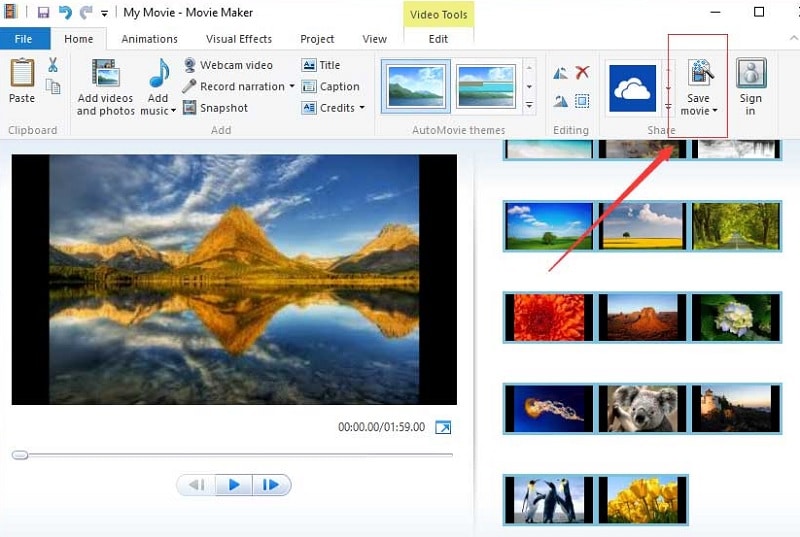
Step3Instead of clicking on Save Movie button, click on the small triangle icon on Save Movie button. Click on Recommended for this project option. You can hold your mouse pointer on the option for a few seconds before clicking to check out the different parameters of your video file that you are going to save.

Step4The Save Movie dialog box will open on the screen. Go to the Save as type section and make sure it is selected for “MPEG-4/ Vide File”. MP4 is the abbreviation of MPEG-4. Finally, click on Save button and your video file will be saved in MP4 file format as per the destination you have chosen.
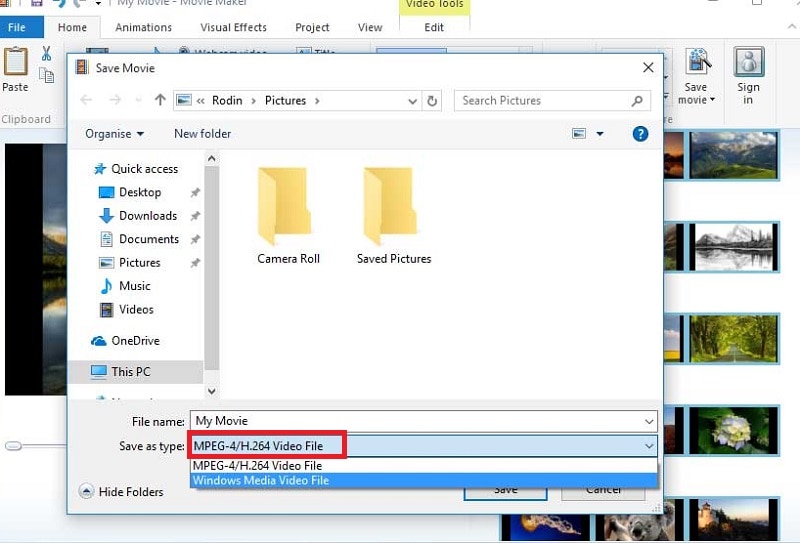
Part 2. Windows Movie Maker Alternative to Save as MP4
We have already stated that Windows Movie Maker from Microsoft has been discontinued in Window 10 and Windows 11. Instead, there is a basic video editor available under Photos app. Therefore, if you are looking for a Windows Live Movie Maker MP4 alternative, we recommend Wondershare Filmora.
Wondershare Filmora is a professional video editor where you can edit your videos like a pro and save your edited video as MP4 file format. You get more features on Filmora in comparison to Windows Movie Maker as it is a premium video editor. In fact, Filmora is easy to operate thanks to its super intuitive user interface. Here are the steps to export a video as MP4 format.
Free Download For Win 7 or later(64-bit)
Free Download For macOS 10.14 or later
Step1Download and install Wondershare Filmora. Click on New Project option on the welcome screen. Drag and drop your video clips into Project Media folder. Thereafter, bring them onto the timeline.

Step2Edit the video clips, add effects and animations as well as titles. Once your editing is done, click on Export button.

Step3Select MP4 file format on the left corner and specify the file name. Select the destination folder from Save To and other parameters as required. Finally, click on Export button.
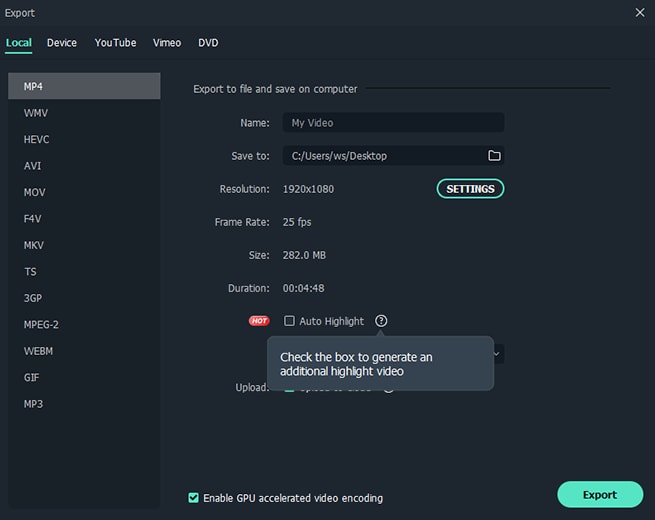
Related FAQs of Movie Maker
The default file format of Windows Movie Maker is MP4. There is also an option to save video file as WMV format.
If you want to convert a movie maker file to MP4 file format, you can open the file in Windows Movie Maker and save the file as MP4. You can also use a video converter such as VideoConverterFactory to convert a movie maker file to MP4.
By default, Windows Movie Maker saves video files under My Documents or Documents folder as per Windows operating system you have on your PC. If it is not available there, you can check My Videos or My Pictures folder on your hard drive under User folder hierarchy.
If you are using Windows Movie Maker on your PC, we have stated how you can save your video file as MP4 format. We have also stated how to convert Windows Movie Maker file to MP4 format easily. We have also recommended the best Windows Movie Maker alternative as Wondershare Filmora where you get more video editing features as well as wide range of video file formats.
Free Download For macOS 10.14 or later
Step1Download and install Wondershare Filmora. Click on New Project option on the welcome screen. Drag and drop your video clips into Project Media folder. Thereafter, bring them onto the timeline.

Step2Edit the video clips, add effects and animations as well as titles. Once your editing is done, click on Export button.

Step3Select MP4 file format on the left corner and specify the file name. Select the destination folder from Save To and other parameters as required. Finally, click on Export button.

Related FAQs of Movie Maker
The default file format of Windows Movie Maker is MP4. There is also an option to save video file as WMV format.
If you want to convert a movie maker file to MP4 file format, you can open the file in Windows Movie Maker and save the file as MP4. You can also use a video converter such as VideoConverterFactory to convert a movie maker file to MP4.
By default, Windows Movie Maker saves video files under My Documents or Documents folder as per Windows operating system you have on your PC. If it is not available there, you can check My Videos or My Pictures folder on your hard drive under User folder hierarchy.
If you are using Windows Movie Maker on your PC, we have stated how you can save your video file as MP4 format. We have also stated how to convert Windows Movie Maker file to MP4 format easily. We have also recommended the best Windows Movie Maker alternative as Wondershare Filmora where you get more video editing features as well as wide range of video file formats.
Also read:
- 2024 Approved TikTok Face Zoom | Create Your Face Zoom TikTok Now
- New 2 Actionable Ways to Extract Subtitles From MKV Videos without Quality Loss for 2024
- Updated Guide To Creating The Perfect VHS Effect Look in Premiere Pro for 2024
- 2024 Approved Create Stunning Videos Like a Pro with Filmora. Learn About Its Benefits and some Amazing Video and Audio Editing Features Such as Split Screens, Keyframing, Etc
- 2024 Approved Do You Need to Make Your Video More Immersive? You Can Make It 60 FPS to Achieve That. And Here Are the 5 Best Tools that You Can Use
- How to Make a Time-Lapse Video Online
- New In 2024, How to Make Video Fade to Black in Movie Maker Easily
- In 2024, How To Polish Your Music Video Edits Using Filmora
- New 9 Best Sparkle Effects Photo and Video Editors You Should Know for 2024
- New In 2024, Hard to Remove Black Background in After Effects?
- Updated In 2024, How to Create a PowerPoint Looping Slideshow
- How to Make Animated Text Video on Computer/iPhone/Android/Online for 2024
- Updated How to Combine Videos Into One on Instagram for 2024
- New In 2024, Top 12 AI Video Generators to Pick
- 2024 Approved Top 31 Video Trimmers That Will Save You Time in Ediitng
- New Discover Vintage LUTs Premiere Pro Free and Paid Options Available
- Updated Are You Excited to Learn About a File Format that Helps in Easy Transfer? We Are Talking About the 3GP Format. Stay with Us and Get to Know More About It
- Updated 15 Camera Shake Preset for Premiere Pro for 2024
- In 2024, Doable Ways to Create Transparent Background in Procreate
- 2024 Approved Learn How to Use 3D Camera Tracking in Adobe After Effects and Take Your Skills to the Next Level
- In 2024, How to Add Text in Adobe Rush
- Looking For the Best VHS Video Effect Makers? Get To Know the Top List for 2024
- 2024 Approved New Video Inspiration for Birthday Slideshow
- Updated In 2024, KineMaster Templates 101 How to Get the Most Out of Video Templates
- New 2024 Approved How to Blur Faces in Your Video on iPhone
- Updated 15 Free Cinematic LUTs for Your Film for 2024
- 2024 Approved Stunning Glitch Effect and Its Creation Steps for Premiere Pro
- In 2024, How To Change Vivo Y100i Power 5G Lock Screen Clock in Seconds
- 3 Ways to Unlock Apple iPhone 12 mini without Passcode or Face ID | Dr.fone
- How to use Pokemon Go Joystick on Vivo Y78+? | Dr.fone
- How to Mirror Apple iPhone 15 Pro to Mac? | Dr.fone
- How To Fix Unresponsive Phone Touchscreen Of Honor Magic V2 | Dr.fone
- How to Bypass Activation Lock on Apple iPhone XS Max or iPad?
- In 2024, 10 Free Location Spoofers to Fake GPS Location on your Motorola Moto G14 | Dr.fone
- In 2024, Top 4 Ways to Trace Nokia XR21 Location | Dr.fone
- In 2024, How to Unlock Poco C51 Pattern Lock if Forgotten? 6 Ways
- How to Reset a Infinix Zero 5G 2023 Turbo Phone That Is Locked | Dr.fone
- Title: Fun & Easy Masking Tricks in Filmora for 2024
- Author: Chloe
- Created at : 2024-05-20 03:38:31
- Updated at : 2024-05-21 03:38:31
- Link: https://ai-editing-video.techidaily.com/fun-and-easy-masking-tricks-in-filmora-for-2024/
- License: This work is licensed under CC BY-NC-SA 4.0.

